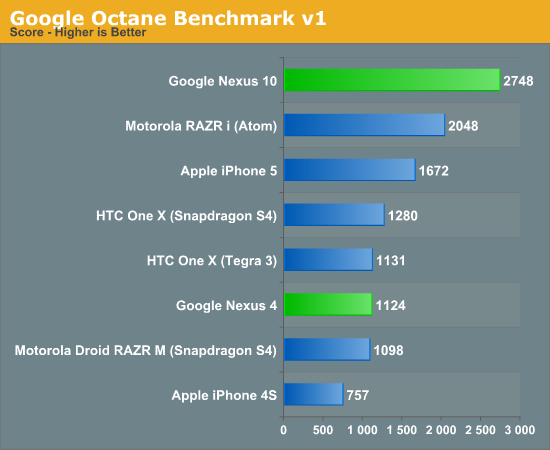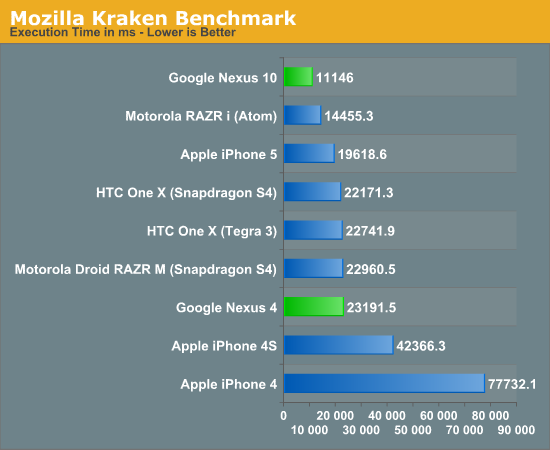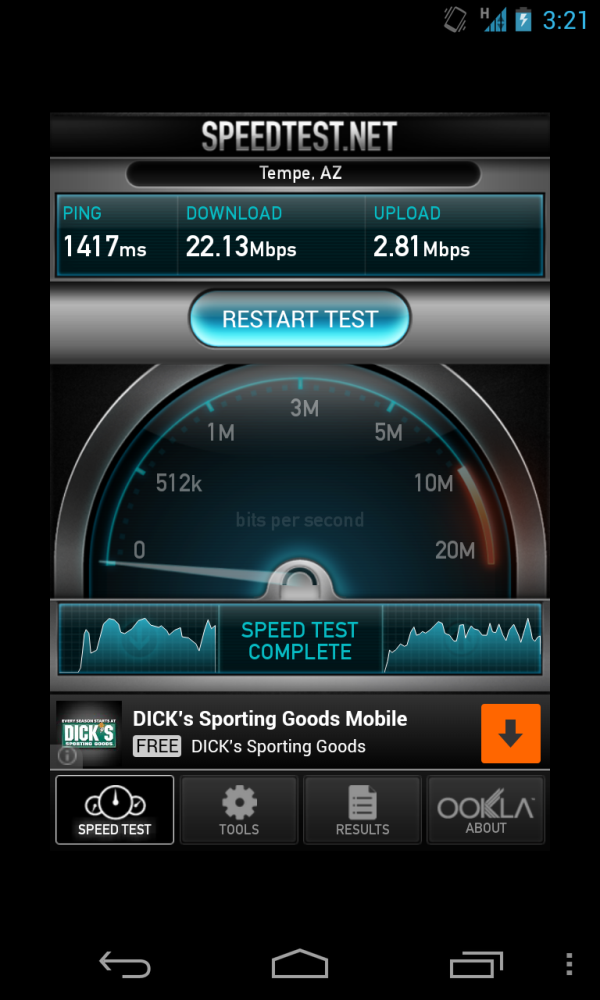Google Nexus 4 and Nexus 10 Performance Preview
by Anand Lal Shimpi & Brian Klug on November 2, 2012 11:00 AM ESTEarlier this week Google announced two new flagship Nexus devices: the Nexus 4 smartphone and the Nexus 10 tablet. We received review samples of both earlier this week, and while we're hard at work at full reviews of the devices we couldn't help but share all of the test data we've been able to amass at this point.
For those who aren't familiar with it, the Nexus 4 features Qualcomm's Snapdragon S4 Pro SoC - a quad-core 28nm Krait CPU with Qualcomm's next-generation Adreno 320 GPU. The combination proved quite formidable in the MDP/T we tested, as well as LG's recently announced Optimus G. The SoC drives a 4.7-inch 1280 x 768 IPS display and is paired with 2GB of LPDDR2 memory. The Nexus 4 ships unlocked with 8GB of NAND for $299 without a contract ($349 for the 16GB version). Pair that with DC-HSPA+ support and you get an absolute killer smartphone for use on T-Mobile: no contracts, very low monthly fees, and compelling cellular performance:
Brian will talk more about the combination in his full review, but rest assured that the lack of LTE is workable depending on T-Mobile coverage where you live/travel to.
The Nexus 10 also boasts a brand new SoC: Samsung's Exynos 5 Dual. The Exynos 5 Dual features two ARM Cortex A15 cores running at 1.7GHz as well as ARM's own Mali-T604 GPU. This happens to be the exact same platform used in the new Chromebook, just running Android. The Nexus 10 features a 10.1-inch 2560 x 1600 display, giving it the same resolution as the 13-inch MacBook Pro with Retina Display - but in an even smaller form factor. Google is also aggressive on Nexus 10 pricing: the 16GB WiFi-only tablet sells for $399, with the 32GB version going for $499.
Both Nexus devices run Android 4.2 and are guaranteed to be the first devices to be updated to upcoming Android revisions for the foreseeable future (it's the power of Nexus).
We haven't had a ton of time to test the devices and put this together so you're going to see combined performance charts throughout the rest of this article.
CPU Performance
The big story when it comes to CPU performance is a look at how the Cortex A15s perform under Android. Unfortunately we're still left with mostly browser based benchmarks to measure CPU performance, which actually highlights a major issue in our testing: Android V8 optimization doesn't seem to be anywhere near as good as it is under Chrome OS or Windows. As a result, all of the Nexus 10 performance scores end up slower than the new Chromebook - despite using the same SoC and running Chrome on both platforms. It's also possible that the Exynos 5 Dual in the Chromebook is allowed to burn a bit more power, translating to better performance, but either way the solution here in the Nexus 10 doesn't look as good across the board.

SunSpider performance is good, but not significantly better than Qualcomm's Krait based Snapdragon S4. Both the iPhone 5 and RAZR i are able to outperform the Nexus 10. The S4 Pro based Nexus 4 tends to be in line with other S4 based devices - SunSpider doesn't really give much credit to the extra 2 cores.

BrowserMark puts the Nexus 10 behind many platforms that should be faster, I'm even wondering here if there's some hard partitioning of memory bandwidth between the CPU and GPU to drive the 2560 x 1600 display that's simply choking the CPU here.
The Nexus 4 does ok, but again there seem to be some V8 optimization issues at work here under Android 4.2. At 1.5GHz it should deliver at least the performance of the dual-core Snapdragon S4 solutions.

Octane is the first test where the Cortex A15s are really able to flex their muscle - the Exynos 5 Dual based Nexus 10 manages to outperform the RAZR i by 34%, and compared to the A6/Swift based iPhone 5 the advantage grows to 64%.
The Nexus 4 performs about in line with other Snapdragon S4 based devices, although once again the extra 2 cores don't seem to be doing much for it here at all.

Kraken also paints the Cortex A15 based Nexus 10 in a good light: there's a 30% advantage over the RAZR i and a 76% advantage over the iPhone 5. These numbers will shrink a bit compared to other tablets, but not by much. The Nexus 4, once again, ends up performing similarly to dual-core Snapdragon S4 based devices.
Overall, the Nexus 10 results show us some real promise for what we can expect from ARM Cortex A15 based SoCs. The potential upside to this new architecture is huge.

















244 Comments
View All Comments
Aenean144 - Saturday, November 3, 2012 - link
People know that the Apple A5 SoC is an Apple design. It wasn't custom as A6 derived SoCs, and used a lot of off the shelf IP, but the A5 was all Apple.It might be more convincing if Samsung continued to use PowerVR GPUs in Exynos, but since they don't, it's seems pretty clear that the A5 is an all Apple design.
dyc4ha - Saturday, November 3, 2012 - link
'Apple design' is extremely misleading. They didnt design anything inhouse until A6, what they did with A5 was: "Here I want these specifications, make it happen" and Samsung and Powervr delivered.Aenean144 - Tuesday, November 6, 2012 - link
It takes design to take IP blocks, lay them out in a die/SoC, and and fab them to the desired performance/power characteristics. They are gradually making things more and more custom than licensing IP, yes, but that still takes work.TI does this with OMAP. Samsung does this with Exynos. You don't hear people say that TI didn't design OMAP nor hear that Samsung didn't design Exynos, do you?
darwinosx - Friday, November 2, 2012 - link
Apple iPhone 4 and now the iPad 4 beats the snot out of these Android devices.Better fit and finish, better support, better build quality, better app quality and selection, no malware, no carrier bloatware, no Google spying on your every move and selling the information. It's called innovation in design of chipsets and handset while maintaining high standards all the way around.
You can't buy them in the bargain bin like even the latest Android devices or buy them at cost like Googles pathetic attempt to get someone, anyone to buy an Android tablet.
On top of that the Androidians are twisting themselves into knots explaining why a glass back, no sd card slot, no LTE, and no removable battery are all of a sudden a good thing after criticizing Apple for those very things. It's hilarious to watch.
Meanwhile AT&T is deprecating HSPA as quickly as it can and good luck with getting a decent signal from T-Mobile. Assuming they are even around a year from now.
But hey you still have widgets....so there's that...
The iPhone 5 is what happens when you are the customer. The Nexus 4 is what happens when you are the product.
A5 - Friday, November 2, 2012 - link
You haven't been banned yet?dyc4ha - Saturday, November 3, 2012 - link
Tony Swash from dt most likelyjuicytuna - Friday, November 2, 2012 - link
I think Anandtech tested a defective Nexus 4. Engadget managed to hit 30 fps in Egypt HD offscreen in their review. Hopefully its just a one off bad unit.tuxRoller - Sunday, November 4, 2012 - link
Different 4.2 builds, most likely, rather than defective unit.lilmoe - Friday, November 2, 2012 - link
Why do you guys always have slightly different devices on each chart in the benchmarks? I would be better if you kept the same devices in all comparisons... It's kinda confusing...the_engineer - Friday, November 2, 2012 - link
Why are the iPad screen numbers left out of the "Display" section? It looks like the Nexus 10 is pitted against smartphones here.. Kind of puzzling. Is it because you've only run these screen benchmarks on phones so far?I've got one of these bad boys on order (iPad 4 w/ VZW LTE) but your numbers here for the N10 are pretty compelling. contrast especially. I'd really love to compare its display head to head vs the 3rd/4th gen iPad screens. Especially that contrast ratio on the N10 are very impressive. Microsoft made a point of this being a differentiation in their surface VS the iPad as well (contrast ratio & brightness), so I'm really looking forward to a "tablet display shootout" of sorts, even if it's just in the numbers.
Thanks for your hard work, I've been listening to your podcasts when I can and I find them to be a great supplement to the news & reviews you guys turn out. Keep up the good work!